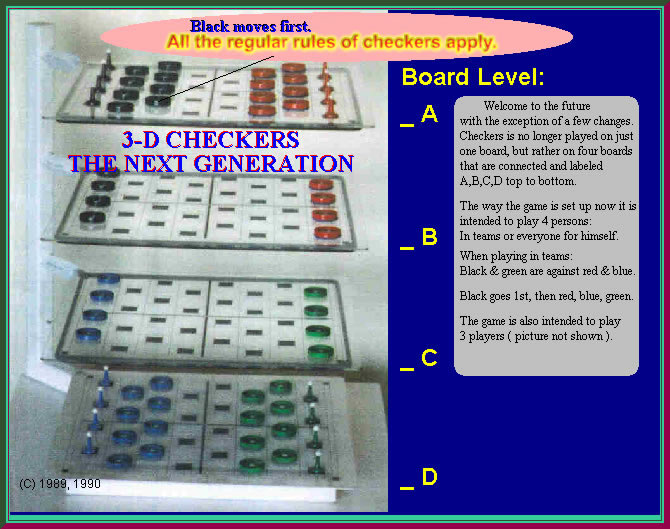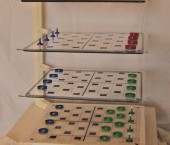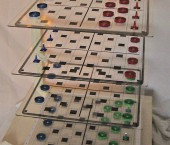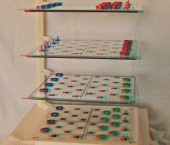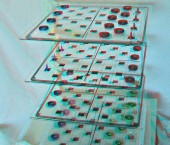‘3‑D Checkers — The Next Generation’ — Paul Glover © 1989 1990 — 2011
3D Checkers relies on all the official rules for Checkers. This includes the rule that a player must capture, when able to do so, rather than make a non-capturing move. The player(s) that have no pieces or cannot move loses.
The only change to the game is the fact that there are three more boards added. The game also may be played by 2, 3, or 4 players in teams or everyone for themselves.
When playing 3 players the black is removed and the blue pieces are put along the
back row of all 4 boards. However because of the dimensional factor, there is a need
for additional instructions as to how the pieces move dimensionally.
Teams: -Black / Green- vs -Red / Blue-.
(Or: Player‑1 plays Black/Green and Player‑2 plays Red/Blue)
Order of Play: Black moves 1st, then Red, Blue, Green in that order at all times.
Uncrowned Piece may only move forward on black squares as in regular checkers. However going straight up/down does not constitute a backward movement.
Capture of a piece is as in regular checkers for all pieces on the flat board, however
when capturing from one level to another it may:
- Capture the opposing piece that is directly above the square that it is on, and land
on the square that is directly above the opposing piece, therefore going from level
‘A’ capturing the one on level ‘B’, and landing on level C (A1 x B1 landing on C1). - Capture the opposing piece that is diagonally forward and above the square that it
is on. For example:
A Green checker on D25(near bottom left corner):..- could capture an opposing piece that was on D22 and land on D18.
- could capture an opposing piece that was on C22 and land on B18.
- could capture an opposing piece that was on C25 and land on B25.
(This would apply both going up and down in order to capture a piece or pieces.)
Crowning of a piece is the same as in standard checkers (by moving your piece to
the opposite side of the board to any of the four levels).
- When a CAPTURED move brings a Single Checker to King’s row, he may also
continue capturing directly above or below the square that it is sitting on (the
square on Kings’ row). He cannot leave Kings’ row until he is crowned. He may
then leave on the following move. The KING may now move forward and
backwards.
Closing of a Board Level is described as “Closed” when there is only one
Checker, King, Prince or Crowned Prince of any colour left on that board level. The
first level that can close will be ‘A’ or ‘D’.
- No Single Checker or King may go to a closed level. That last Checker piece on
the closed level, is frozen there until, when he chooses to (or forced, by having to
jump), must only move vertically or vertically diagonal to a level that has checker
pieces on it (this does not apply to a Prince or Crowned Prince). - When the last piece on a closed level is moved off, there will be no pieces on that
level. That level is now considered FINISHED, and no piece may go to a
finished level. This is shown, by putting a small piece of paper on that level. - For a level to be closed, it will be one of two things:
1. There will be no pieces on any other levels above it. OR
2. There will be no pieces on any other levels below it.
PRINCE
There are four Princes per side that are placed on King’s row, level ‘A and D’.
Black / Blue: #1 #4
Red / Blue: #29 #32
A Prince Captures and Moves as in standard checkers, ON A LEVEL.
When capturing from one level to another, he may move only one level at a time,
landing on the same level as the captured piece. For example: a Green Prince on ‘D29’
can capture a Red piece on ‘C25’ landing on ‘C22’. It can move on a Closed Level.
A Prince Moving to a Closed Level reopens that level. This is because there
are now two pieces on that level. It cannot move to a finished level.
A Crowned Prince (Captures after reaching the opposing side on any level)
has a checker piece put under it. It may now also capture the same as a Checker
KING. It thus now has a choice. For example: a Green Crowned Prince on ‘D29’ can
capture a Red piece on ‘C25’ landing on ‘C22’ or land on ‘B22’. That same piece on
‘D29’ could now also capture straight up, capturing ‘C29’ and landing on ‘B29’
(D29 x B29) or capturing straight up/down from the square that it is sitting on.
A Crowned Prince Moving to a Closed Level re-opens that level. This is
because there are now two pieces on that level. It cannot move to a finished level. A
Crowned Prince may also move freely on a Closed Level.
Recap on the above written: All possible moves, captures and the Prince.
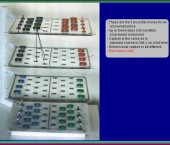
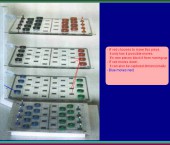
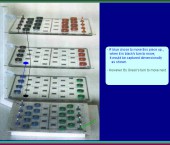
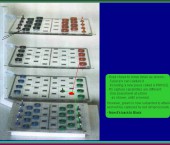
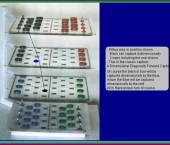
As noted earlier in the game ‘Chess – The Future Generation’:
“It is very strongly recommended to use a white stone or object to indicate who’s
move it is. In fact the move is NOT complete until the white stone is passed to the next
player, which says: ‘That is my move!’ This is done because everyone can and will lose
tract of who’s turn it is to play”
Checker Notation shows the start of a move and the end of the move. This can
be done by stating the board level 1st with a capital letter, followed by where the
checker is located. – Then, where the checker is going to stop (Board level, checker
location). The start of a game is shown this way:
| -BLACK- | -RED- | -BLUE- | -GREEN- |
| 01. A11 – B15 | A22 – B18 | D9 – C13 | D24 – D20 |
| 02. B15 x B22 | A26 x C17 | C13 x C22 | D22 x B22 |
| 03. … | A25 x C18 | etc. | … |
Notice how Green captures Blue going straight up from D22 to B22.
When there are only Three Players (my favorite), Black is taken out and
Blue is stretched out on the King’s row on all four levels. The four Princes are placed
on B1, B2, B3 and B4 as shown below. Red goes 1st followed by Blue and then Green.
(If you know what you are doing, Blue has the advantage)
As noted before make sure
that all the boards are facing the same way
(the double corner or double black square #28, #32 is on the right side).
— — — — — — — — — — — — — — — — — — — — — — — — — — —
Now the last comment I made about the boards all facing the same way is very important for the above game. Now, here it is September 2016 and I have not yet written publicly about the same game as mentioned above but this time, every other board is given a quarter turn to the right. As a result, by moving a checker piece down or up one level, the checker piece can move sideways in a very straight line (sideways is not backwards) or directly forward in a very straight line. This gives the game a very real bizarre twist! The last time I wrote about this and sent away for copyright was back in 1990. Here goes. The name I gave it back then was:..
“3‑D Checkers — The Future Generation”
Welcome to the final frontier of the Future Generation. Now that you have mastered the dimensional strategy of the two previous games, you are now ready for a new concept in checkers which will change all the strategy that you have previously learned. The board levels “B” and “D” are given a ¼ turn to the right. The numbering for those boards starts with 1 in the top left corner. All the rules for regular checkers still apply, it’s just the board to board movement and capture that needs clarifying.
SINGLE MAN:
All the rules are the same, however a Single Man (not yet crowned) is now able to move rank (side to side) or file (forward). This is done by changing levels.
CAPTURE:
Capture is done in a forward manner or on a rank. For example if a red piece was on A32 it could capture another colored piece on B28 and land on C24 (A32 x C24) going forward. Or the same piece on A32 could capture B31 and land on C31 (A32 x C31) going sideways. Of course a combination of those kinds of jumps could happen, capturing forward and then sideways all in one move.
PRINCE:
You will notice that the Princes in this game have become inferior or less capable until the end of the game. They are able to move from one level to another, and capture on the level that they are on.
CROWNED PRINCE:
The Crowned Prince is as the above but also has the capabilities of capturing like a King.
… … … … just when you had it all figured out, it changed.
For a variation, the same game can be played without the Princes.

